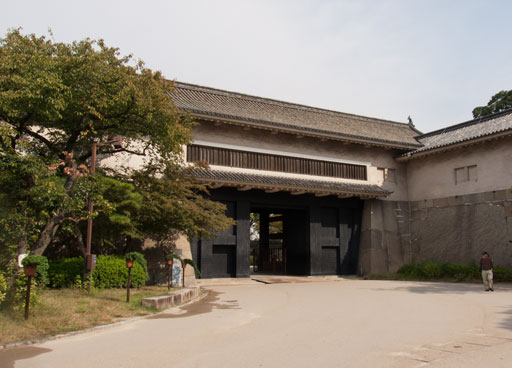17 October 2011
Osaka Castle was built beginning in 1583 as the headquarters of Hideyori Toyotomi, one of the leading figures of the Warring States Period. It has been carefully maintained by the people of Osaka who remember how Hideyori briefly made their city the effective capital of Japan.
The castle is a huge complex surrounded by a wide deep moat, with high curved stone walls intended to be impossible to climb.


Four massive gates, one on each side, allow entry into the inner grounds.


Hideyoshi was born in 1536 or 1537, the son of a poor farmer. At the age of 12 he entered the service of Nobunaga Oda, the leading warlord of the time. He rose quickly in Nobunaga’s service, demonstrating fierce loyalty, exceptional leadership ability and an amazing grasp of military strategy. (Some Japanese historians claim that Hideyoshi was one of history’s great natural military geniuses, comparable to Alexander or Napoleon.)
Hideyoshi became one of Nobunaga’s top generals and with his help Nobunaga was able to gain control over most of Japan. When Nobunaga was assassinated in 1582 Hideyoshi declared himself his successor. He took revenge on Nobunaga’s killer and forced the other feudal lords to accept his leadership. He was soon appointed chief adviser to the Emperor, becoming the effective ruler of all Japan.
Instead of concentrating on consolidating his rule Hideyoshi devoted much of his attention and resources to a bloody invasion of Korea, hoping to establish a Japanese empire on the mainland. These plans collapsed when Hideyoshi died in 1598, leaving his 5 year old son Hideyori as his heir.
The other feudal lords would not accept the rule of a child and rose up against him. Eventually Ieyasu Tokugawa established his supremacy, becoming the first of the Tokugawa Shoguns in 1603, thus ending the Warring States Period.
However the local lords in the Osaka area remained loyal to Hideyori and rose up against Ieyasu. 1615 a Tokugawa army overran and burned Osaka Castle and the Toyotomi family was wiped out. Ieyasu ordered that the castle be rebuilt on an even grander scale as a symbol of his power.
The interior of the complex is now a beautifully landscaped park.


This building served as a military headquarters during World War II.

The castle’s main tower was originally a 5 story black structure with gold trim designed by Hideyoshi. This was burned in 1615 and the Tokugawas replaced it with an even larger white tower.

However in 1665 the tower was struck by lighting and burned to the ground. (An obvious disadvantage of making your castles out of wood.) In 1928 the city of Osaka raised funds to rebuild the main tower. Though it was supposed to be a reconstruction of the Tokugawa tower, in view of what had happened to its predecessor the architect insisted on building it of reinforced concrete.

This proved to be a wise choice. During World War II the castle served as a military command post and all of the remaining Edo Period buildings were destroyed by American bombs. The main tower suffered relatively little damage.
Today the main tower is a museum devoted to Hideyoshi and the history of the castle. Unfortunately the most interesting exhibits are not allowed to be photographed. Here is a view from the top showing one of the gold-plated fish ornaments intended to protect the tower from fire.

Here is a display of some of the other ornaments that originally decorated the walls.



An imposing edifice but what a bloody history.
Like your photo.